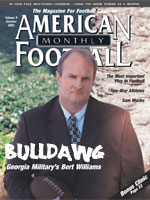AMERICAN FOOTBALL MONTHLY THE #1 RESOURCE FOR FOOTBALL COACHES
Article CategoriesAFM Magazine
|
In Your Face and Aggressive!Play DB the Buster Wayby: Tim Schaffner Defensive Coordinator, Garden City Community College © More from this issue In order to be successful against todayís high-powered offenses, and all the skilled personnel they can throw at you, defensive backs must possess incredible physical talent and mental tools. They must be able to run with the fastest, jump with the highest and hit with the hardest. In addition, they must have very selective memories, be without conscience and have no guilt or remorse. Their abilities and guile are tested on every snap; they are constantly under the gun, and even the most uneducated fans know when a DB gets beat. When they succeed itís because they have been trained to play that way, and when they fail, the game can hang in the balance. A DBís margin for error is zero, and th....The full article can only be seen by subscribers. Subscribe today!
|
|
|||||||
| HOME |
MAGAZINE |
SUBSCRIBE | ONLINE COLUMNISTS | COACHING VIDEOS |
Copyright 2025, AmericanFootballMonthly.com
All Rights Reserved





